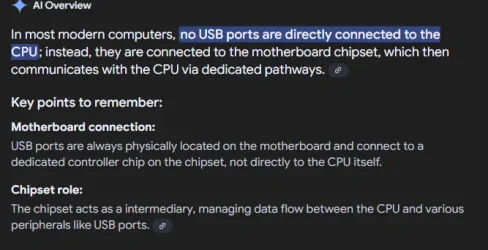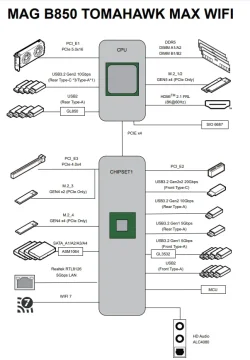Gas
Well-known member
- Local time
- 11:35 PM
- Posts
- 25
- OS
- Windows 11
Hi all, I am going to build a new PC, the motherboard will be an (MSI MAG B850 TOMAHAWK MAX WIFI) on the manual I see that some of the rear USB ports are from CPU and some are from chipset:
● 1x Clear CMOS Button
● 1x Flash BIOS Button
● 1x HDMI™ port
● 3x USB 10Gbps Type-C ports (From CPU)
● 2x USB 10Gbps Type A port (From CPU & B850 Chipset)
● 1x USB 5Gbps Type A (From B850 Chipset)
● 4x USB 2.0 connectors (From HUBGL850)
● 1x 5G LAN (RJ45) port
● 2x Wi-Fi antenna connectors
● 2x audio jacks
● 1x Optical S/PDIF Out connector
I wonder if there is any difference in performance between these types of USB ports. I did some web search but i did not find any clear answer, I am sure that in the forum there is someone informed about this matter.
Thanks in advance for any help/clarification
Gas
● 1x Clear CMOS Button
● 1x Flash BIOS Button
● 1x HDMI™ port
● 3x USB 10Gbps Type-C ports (From CPU)
● 2x USB 10Gbps Type A port (From CPU & B850 Chipset)
● 1x USB 5Gbps Type A (From B850 Chipset)
● 4x USB 2.0 connectors (From HUBGL850)
● 1x 5G LAN (RJ45) port
● 2x Wi-Fi antenna connectors
● 2x audio jacks
● 1x Optical S/PDIF Out connector
I wonder if there is any difference in performance between these types of USB ports. I did some web search but i did not find any clear answer, I am sure that in the forum there is someone informed about this matter.
Thanks in advance for any help/clarification
Gas
My Computer
System One
-
- OS
- Windows 11
- Computer type
- PC/Desktop
- Manufacturer/Model
- Self-made
- CPU
- intel i7-2600
- Motherboard
- Asus P8Z68MPRO
- Memory
- 32 GB TIMETEC
- Graphics Card(s)
- Nvidia RTX 3600
- Monitor(s) Displays
- EIZO CS240
- Screen Resolution
- 1920X1200
- Hard Drives
- Main - Samsung 870EVO
- PSU
- SilentStorm Cool Zero 750W
- Other Info
- Mostly used for photo retouching software, some video slideshows.








